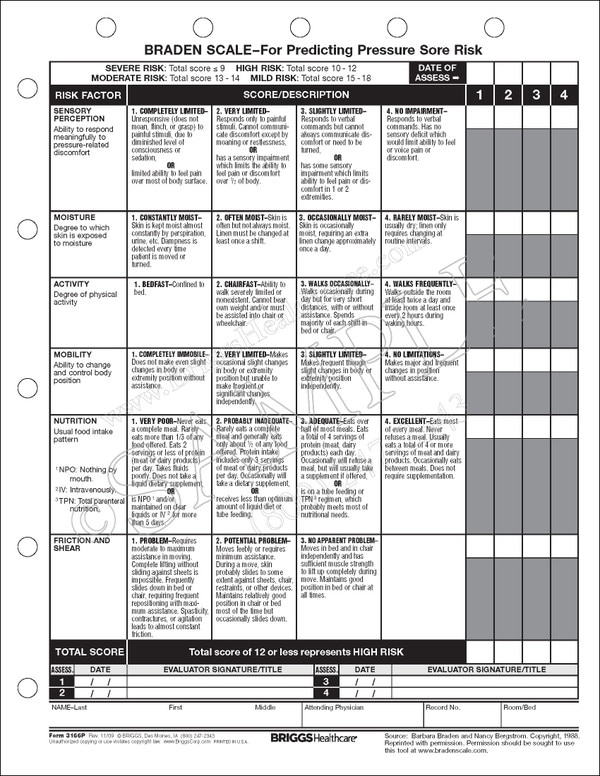Poor nutrition, intravascular volume depletion, and peripheral vascular disease can each lead to unhealthy skin and impaired wound healing, which in turn increases the risk of developing pressure ulcers. Low body weight is also a concern. Weight less than 119 pounds or a body mass index (BMI) less than 20 indicates increased risk for pressure ulcer development [80].
Braden Scale – Assesses each client according to 6 subscales: sensory perception, skin exposure to moisture, the client’s level of activity, the client’s ability to change positions, nutritional intake and the presence of friction and shearing force. Total Braden Scale scores range from 6 to 23 with lower scores indicating higher risk. Total Braden Score Total Braden Q Score Total PURS Score PUAP Risk Category. 14 or higher 26 or higher 0 Very Low Risk 15-18 22-25 1-2 Low (At Risk) 13-14 17-21 3 Moderate Risk 10-12 Braden Scale, Braden Q Scale and PURS Score Risk Categories. BRADEN SCALE FOR PREDICTING PRESSURE SORE RISK Patient’s Name Evaluator’s Name Date of Assessment SENSORY PERCEPTION ability to respond meaningfully to pressure-related discomfort 1. Completely Limited Unresponsive (does not moan, flinch, or grasp) to painful stimuli, due to diminished level. Why elevating the Braden Scale from routine task to top tool helps nurses better assess,understand and prevent pressure injuries.
Printable Braden Scale Assessment Form


Printable Braden Scale Blank Form
Recent weight loss, decreased nutritional intake, inadequate dietary protein, and impaired ability to feed oneself have been identified as risk factors for pressure ulcer development. An estimated 50% of elderly patients admitted to hospitals have suboptimal protein nutrition [80]. When there is a sustained deficit of protein as an energy source, skin and soft tissues become more vulnerable to injury. In managing patients with pressure ulcer, or those at risk, the amount of protein in the diet appears to influence prognosis for recovery and prevention. In one study, patients who received a 24% increase in protein intake had significant improvements in ulcer healing and prevention of new skin injury compared to those who received a 14% increase [24].